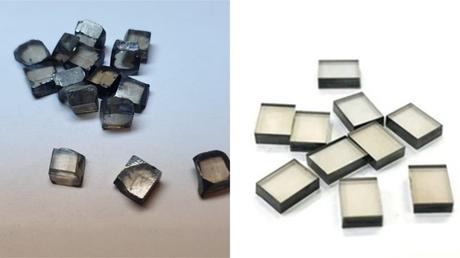No subject has generated so much buzz and debate among jewelers and diamond enthusiasts since the 1990s when diamonds started being sold online.

"Hot potato!"
By now it really shouldn't be a hot potato. Lab-grown diamonds (LGD) are here to stay. Attention and sales are growing. They're finding an audience wide enough that Pandora, the world's largest jeweler by volume, has ditched natural diamonds - using lab-grown stones in all of their new designs.
"Lab-Grown Diamonds are fake!"
Negative. They are not fake. Some people (falsely) presume they are simulants like CZ or Moissanite which simulate - or resemble - diamonds.
Lab-grown diamonds are not simulants. They are real diamonds, produced using chemical synthesis.
"Aha! Synthetic is fake. Fight me!"

Here again, people (wrongly) associate the word "synthetic" with fake. That's why lab-grown diamond sellers prefer not to use that word. It creates confusion.
The FTC agrees. They removed the word synthetic as a descriptor for LGDs in 2018. However...and this is word for word... The Commission does not "prohibit" marketers from ever using "synthetic" to disparage lab-grown diamonds.

Seriously. According to the FTC you can shout "Ya lousy synthetic!" at a lab-grown diamond - if you want to hurt its feelings, I guess.
"But they ARE different."
In a "diamonds are forever" sense, yes. They are not billions of years old. They are grown in factories over a period of 1-4 weeks. At the conclusion of the growth cycle, LGDs are chemically and optically identical to natural diamonds (note that, unlike the FTC, I didn't say physically - more on that later).

Rough LGDs are polished with the same tools and brought to market in the same manner as earth-mined diamonds. They have an identical refractive index and optical qualities. They are graded using the same color and clarity scale as natural diamonds.
Lab-Grown Diamond Treatments
The majority of lab-grown diamonds have a brown undertone. Producers frequently use post-growth treatments to bleach the rough so it's not so brown. Depending on output quality and the process used, it's possible to reduce the brown, change it to a softer grey or pink or eliminate the undertone entirely. This is a very common practice. According to IGI, the institute grading the majority of the world's LGDs, more than half the CVD-produced LGDs they grade have had their color improved.

The high end of lab-grown quality continues to improve, and there are now CVD productions capable of producing colorless rough without post-growth treatment. The IGI grading report will tell you what method was used, CVD-produced or HPHT-produced, and whether post-growth treatments were used or not used.
While these details are not part of the traditional diamond Cs they are components that may be considered value factors by some.
From coffee shops and water coolers to showrooms and strategic meetings, the diamond and jewelry industry is debating how these lab-grown newcomers fit or don't, into their practices and philosophies. When it comes to the most common questions, here are the typical yes, no, and center positions.
Appearance Do they look the same?Yes: There is no visual difference. LGDs have an identical refractive index and the same brightness, fire, and sparkle potential as natural diamonds.
No: Even the majority of treated LGDs have brown, grey, or pink undertones, and gemologists can be trained to identify distinctive inclusion types and patterns which indicate lab-grown origin.
Center: There may be clues, but it's impossible to decisively state lab-grown or natural origin based on appearance without close analysis and/or using grading laboratory equipment.
Value
Are they less expensive?Yes: That is the most appealing aspect of LGDs. Lab-grown diamonds are already notably less expensive. They are created in controlled, cost-effective conditions. Buyers get a higher quality and larger lab-grown diamond for the same budget.
No: Prices of LGDs continue to drop, and the principal of accelerating change suggests they will lose value with time, unlike natural diamonds which historically gain in value.
Center: Indeed, natural diamonds increase in value. But consumers can't easily recoup buying prices with natural diamonds. The best "investment" for the average shopper is with a diamond seller offering lifetime upgrade programs, where full value of the initial spend can be realized in a future purchase.
Environmental Responsibility
Are they sustainable?Yes: They are planet-friendly. There is no invasive mining, dredging, or caving.
No: The power required to produce them is enormous. When asked to share their energy consumption data the growers have refused.
Center: "Sustainability" is a work in progress. The FTC has issued warnings to LGD sellers using that term without proof. SCS Standards, an organization that has conducted audits for the Responsible Jewelry Council (RJC), has developed a sustainability certification program and there are producers pursuing that certification.
Social Responsibility
Are they "conflict-free?"Yes: Laboratory-grown diamonds are 100% conflict-free, produced by salaried workers in factory environments.
No: Of course they are, but so are natural diamonds. Geopolitically, when conflict minerals surface in small rogue nations like the DRC any diamonds are blocked from legitimate rough trading centers. Shame on LGD sellers for reviving this negative term.
Center: The natural diamond industry has worked diligently to ensure conflict-free channels and bring prosperity to indigenous people upstream. Sales of natural diamonds now sustain tens of millions of people, funding education and infrastructure. Both natural and LGDs have positive planetary propositions.
Symbolism Will you marry meYes: It's so cool that we now command the science and technology required to create the hardest known material in the universe.
No: This was grown in a factory last month, is printed like paper, and doomed to cost less over time. How can one assign emotional value to it?
Center: Lab-grown diamonds are here to stay. Both natural and lab-grown diamonds have a legitimate place in the market. What you do with them is a personal choice.
Summary
Read that last sentence again. There are no "wrong" beliefs when it comes to choice, whether it involves diamonds, gemstones, cuisine, or holiday destinations. Taken as a whole, these relative newcomers to the gem world are attracting some people and repelling others. That's fine.
Diamonds are exceptionally beautiful to many people. How long ago a diamond was created, and the manner in which it came about will matter more to some than others.
One thing is certain: Whatever position you take on lab-grown diamonds - yes, no, or center - you won't be alone.

Comments?
Would you buy a lab-grown diamond? Would you wear one? Would you propose marriage with a LGD? Would you accept a proposal if it was made with a LGD? What do you think will happen in the future with LGD values? What about natural diamond values? Let us know by clicking the comments button below, or use the community link below to share with the entire PriceScope community!
More ReadingLearn how to define brightness, leakage, contrast, and scintillation on our page Diamond Performance Explained.
Take your diamonds on a brightness, fire, and sparkle test drive: Make Comparisons Like an Expert.
Get fast answers to any question: Ask our community of unbiased independent helpers.Ready to find your diamond?
Written by John Pollard
